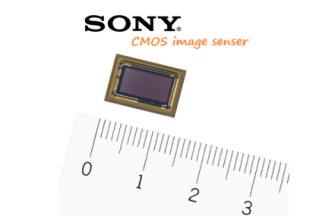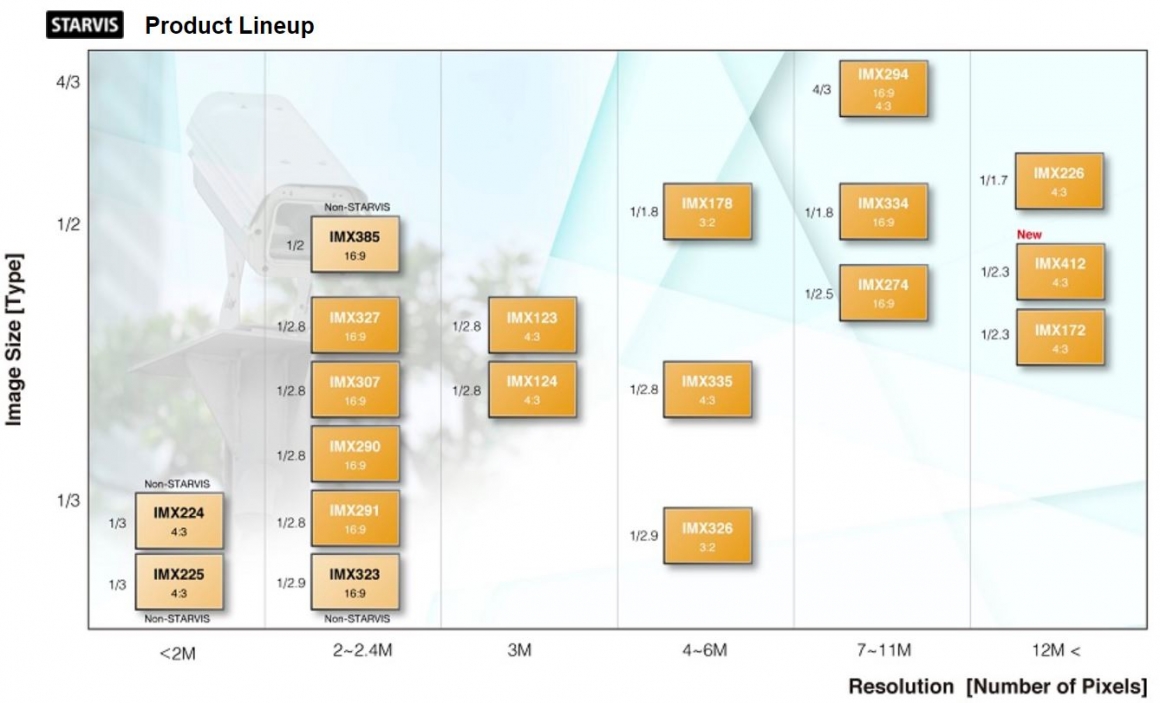Subscribe to EDOM TECH Newsletter
Sony Semiconductor Solutions Corporation
STARVIS CMOS Image Sensor
IMX307LQD/LQR, IMX335LLN/LQN, IMX412-AACK, IMX323LQN
There is a need for surveillance cameras to film with clear images in a variety of environments. Sony's image sensors meet this need by providing high-sensitivity performance suitable for night filming.

STARVIS
The STARVIS is back-illuminated pixel technology used in CMOS image sensors for surveillance camera applications. It features a sensitivity of 2000 mV or more per 1 µm2 (color product, when imaging with a 706 cd/m2 light source, F5.6 in 1 s accumulation equivalent), and realizes high picture quality in the visible-light and near infrared light regions.

Products
IMX307LQD/LQR - Diagonal 6.46 mm (Type 1/2.8) CMOS Solid-state Image Sensor with square pixel for Color Cameras
The IMX307LQD/LQR are diagonal 6.46 mm (Type 1/2.8) CMOS active pixel type solid-state image sensors with a square pixel array and 2.13 M effective pixels. These chips operate with analog 2.9 V, digital 1.2 V, and interface 1.8 V triple power supply, and have low power consumption. High sensitivity, low dark current and no smear are achieved through the adoption of R, G and B primary color mosaic filters. These chips feature an electronic shutter with variable charge-integration time. Learn more >>
IMX335LLN/LQN - Diagonal 6.52 mm (Type 1/2.8) CMOS Solid-state Image Sensor with Square Pixel for Monochrome Cameras
The IMX335LLN is a diagonal 6.52 mm (Type 1/2.8) CMOS active pixel type solid-state image sensor with a square pixel array and 5.14 M effective pixels. This chip operates with analog 2.9 V, digital 1.2 V, and interface 1.8 V triple power supply, and has low power consumption. High sensitivity, low dark current and no smear are achieved. This chip features an electronic shutter with variable charge-integration time. Learn more >>
IMX412-AACK - Diagonal 7.857 mm (Type 1/2.3) 12.3 Mega-Pixel CMOS Image Sensor with Square Pixel for Color Cameras
IMX412-AACK is a diagonal 7.857 mm (Type 1/2.3) 12.3 Mega-Pixel CMOS active pixel type stacked image sensor with a square pixel array. R, G, and B pigment primary color mosaic filter is employed. It equips an electronic shutter with variable integration time. It operates with three power supply voltage: analog 2.75 V, digital 1.05 V and 1.8 V for input/output interface and achieves low power consumption. Learn more >>
IMX323LQN - Diagonal 6.23 mm (Type 1/2.9) Approx. 2.19M-Effective Pixel Color CMOS Image Sensor
It's a full HD support high sensitivity CMOS image sensor with a super small package for industrial applications. WLCSP (Water Level Chip Size Package) technology is used to realize a smaller size while maintaining performace such as visibility. The package size has been reduced to 1/8 the volume of the previous product, which helps to greatly reduce the set size. Learn more >>
Product Matrix
*Sony Semiconductor Solutions Corporation Authorized Distributor
The STARVIS is back-illuminated pixel technology used in CMOS image sensors for surveillance camera applications. It features a sensitivity of 2000 mV or more per 1 µm2 (color product, when imaging with a 706 cd/m2 light source, F5.6 in 1 s accumulation equivalent), and realizes high picture quality in the visible-light and near infrared light regions.

Products
IMX307LQD/LQR - Diagonal 6.46 mm (Type 1/2.8) CMOS Solid-state Image Sensor with square pixel for Color Cameras
The IMX307LQD/LQR are diagonal 6.46 mm (Type 1/2.8) CMOS active pixel type solid-state image sensors with a square pixel array and 2.13 M effective pixels. These chips operate with analog 2.9 V, digital 1.2 V, and interface 1.8 V triple power supply, and have low power consumption. High sensitivity, low dark current and no smear are achieved through the adoption of R, G and B primary color mosaic filters. These chips feature an electronic shutter with variable charge-integration time. Learn more >>
IMX335LLN/LQN - Diagonal 6.52 mm (Type 1/2.8) CMOS Solid-state Image Sensor with Square Pixel for Monochrome Cameras
The IMX335LLN is a diagonal 6.52 mm (Type 1/2.8) CMOS active pixel type solid-state image sensor with a square pixel array and 5.14 M effective pixels. This chip operates with analog 2.9 V, digital 1.2 V, and interface 1.8 V triple power supply, and has low power consumption. High sensitivity, low dark current and no smear are achieved. This chip features an electronic shutter with variable charge-integration time. Learn more >>
IMX412-AACK - Diagonal 7.857 mm (Type 1/2.3) 12.3 Mega-Pixel CMOS Image Sensor with Square Pixel for Color Cameras
IMX412-AACK is a diagonal 7.857 mm (Type 1/2.3) 12.3 Mega-Pixel CMOS active pixel type stacked image sensor with a square pixel array. R, G, and B pigment primary color mosaic filter is employed. It equips an electronic shutter with variable integration time. It operates with three power supply voltage: analog 2.75 V, digital 1.05 V and 1.8 V for input/output interface and achieves low power consumption. Learn more >>
IMX323LQN - Diagonal 6.23 mm (Type 1/2.9) Approx. 2.19M-Effective Pixel Color CMOS Image Sensor
It's a full HD support high sensitivity CMOS image sensor with a super small package for industrial applications. WLCSP (Water Level Chip Size Package) technology is used to realize a smaller size while maintaining performace such as visibility. The package size has been reduced to 1/8 the volume of the previous product, which helps to greatly reduce the set size. Learn more >>
Product Matrix
| Product | Resolution | Image Size | Pixel Size | Max Frame Rate | I/F | Chroma | Application | Technology |
| IMX307LQD/LQR | 1080p-HD | 1/2.8 | 2.9 | 60 | sub LVDS Serial MIPI CSI-2 | RGB | Survelliance | STARVIS DOL HDR |
| IMX335LLN/LQN | 5.0M[4:3] | 1/2.8 | 2.0 | 60 | MIPI CSI-2 | Monochrome RGB |
Surveillance Industry |
STARVIS DOL HDR |
| IMX412-AACK | 12.3M[4:3] | 1/2.3 | 1.55 | 60 | MIPI CSI-2 | RGB | Surveillance | STARVIS DOL HDR |
| IMX323LQN | 1080p-HD | 1/2.9 | 2.80 | 30 | CMOS Parallel | RGB | Surveillance | FI NIR |
*Sony Semiconductor Solutions Corporation Authorized Distributor






